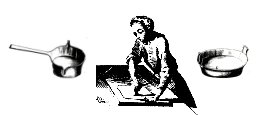Again, a case involving lackeys and valets. Several individuals are
mentioned here, but the story that emerges tends to center on Lebel (who may, given
the dates here, have been denounced by Petit). His is the kind of arrest of a
minor player that makes numerous more prominent persons nervous. Merely being
mentioned in such a case would lead people to draw conclusions. Regarding
the letter to Tallard, for instance, Ravaisson notes:
Pontchartrain's concern that Desforges be
interrogated secretly grows directly from his concern for any families whose
members may be mentioned.
Lebel's very dense deposition does indeed include names of people known from
other sources as sodomites (not to mention some rather catty gossip). It
should not be forgotten however that he probably thought it was in his best
interest to provide as many names as possible.
Overall, this set of documents reads almost like a novel, with a broad sweep
including both tragic and comic elements, an unusually comprehensive look at
the "sodomite scene" of the period and elements of prostitution and child
molestation mentioned alongside of enthusiastically consensual activity. It also
includes the literary trick of leaving unexplained holes in the narrative,
which in this case were probably due to the chaotic state of the files
following the fall of the Bastille.
From CHEZ JIM Books:
An EIGHTEENTH CENTURY VEGETARIAN COOKBOOK:
APRES MOI LE DESSERT - VOLUME II
and a history of the CROISSANT:
AUGUST ZANG AND THE FRENCH CROISSANT
|


18th CENTURY RECIPE: Meal for 10-12: Terrine of Partridge with Cabbage
A terrine is an earthenware pot, most often round, it seems, in the
eighteenth century, and, in earlier times, a chamber pot as well (hopefully the two
uses were not often confused.) It was also a type of cooked dish. Today, if
you order a terrine, it will be hard to distinguish from a paté (many of which
are served in elongated earthenware pots). The Larousse Gastronomique says
firmly this must be served cold. But the Old Regime terrine was closer to a
stew, and served hot (a crock pot, or the dishes served in crockery in some
Asian restaurants, might be considered modern equivalents). It may be that, over
the years, cooks discovered that the dish improved when left to cool and
settle.
Though the Nouveau Cuisinier Royal et Bourgeois lists this entrée as the
first (after the centerpiece) in the first service for its model meal, it only
includes one recipe for a terrine per se (463, 1705 ed):
TERRINE
What is called a Terrine, is a very substantial Entrée: here is what it is.
One must have six Quail, four young Pigeons, two Chickens & a Quarter of
Mutton cut into pieces. Put to cook on the coals in a terrine, on a low fire,
with strips of lard in the bottom, to keep it from burning; ; or small lard cut
into pieces. Once cooked, skim off the grease, & put in its place good Veal
juice, blanched & cooked hearts of lettuce, a little puree of green peas, with
peas or asperagus tips. Let them cook together a bit longer, & and only
serve after skimming well.
A nineteenth century dictionary, the Dictionnaire General de la Cuisine
Ancienne et Moderne (1853), offers this recipe for "old" - eighteenth century?
- style terrine (485):
Terrine in the old style - Cook a plump chicken, a partridge, the saddle
of a hare, a rump of veal and a rump of mutton in bouillon, all larded with
moderately thick lard seasoned with fines herbes and spices. Let all this boil
together. Then peel grilled chestnuts, clean them properly and put them to
cook with the meat. Close the terrine tightly and seal it with firm dough so
that all this cooks in its juices. Skim the fat off the sauce before serving it
and add in then a glass of Canary wine.
These recipes give a good idea of the old version of a terrine. None of
these works offers one specifically for partridge with cabbage, but the
combination otherwise occurs frequently. The following recipe might do perfectly well
on its own, but could also be adapted to a terrine:
Partridge with Cabbage
Take three old partridge; after having cleaned them, truss them like
chickens; lard them with large strips of lard, seasoned with salt, pepper, fine
spices, grated and strained aromatics, parsley and chopped spring onions; line a
casserole with some bits of veal, two carrots, two onions and a half-clove of
garlic; put your partridges on it, cover them with strips of lard; pour some
good bases over them, or some bouillon or consomme; put your casserole on the
fire, take it off; cover it with a round of buttered paper, as well as its
cover; put it on the work surface, with fire under it and hot cinders on it;
let it cook an hour or an hour and a quarter; then prepare the cabbage [see
below for preparation], in which you will cook a cervalas and a piece of small
lard; pare thirty red carrots, as many turnips; give them the diameter of a
one franc piece (their length must be of the height of the mold I am going to
mention); blanch these vegetables; drain them and let them cook in consommé,
with a pinch of sugar to remove the bitterness; having let your cervelas and
your lard cool, take a mold; butter it; put in the bottom a round of white
paper and a band of paper around your mold inside and of its height; cut your
cervelas into pieces like coins and your lard into slices, the thickness of
your cervelas; put in the center of the mold a piece of cervelas; arrange
around it slices of your lard, and so garnish the bottom of your mold with circles
of lard and your pieces of cervelas; lay out around your mold your sticks of
carrots and turnips, mixing them together and tightening them one against
the other; press your cabbages, garnish the bottom of your mold with them, and
continue to garnish the sides with them like a kind of counter wall, so to
speak; leave a hollow in the middle to put your partridges in; put them in the
bottom on their stomachs; fill your mold with cabbages, cutting back anything
that spills over, and press them down, in order to give them a firm
consistency, so that in turning out your partridges, your decoration will not be
disturbed; put a cover on this mold, and keep your partridges warm in a
double-boiler; strain their stock through a silk strainer; add in three skimming
spoons of worked Spanish sauce...; let your sauce cook, skim it, reduce it to the
consistency of a demi-glace; turn your chartreuse over on your dish, remove
the paper, drain it carefully, sponge off the moisture, as as well as
possible, with the corner of a cloth; sauce it with your reduction, and serve.
Take two or three cabbages; cut them into quarters; wash-them; blanche
them: when done, let them cool: bind them; put them in a stewpot; moisten them
with bouillon: if you have a hot coal [?] or some good stocks, use them; add in
some carrots, two or three onions, including one stuck with three cloves, a
garlic clove, laurel, thyme; what's more, so that your cabbage are well filled
out, add in the last of your stewpot; let them simmer three or four
hours;drain them on a white cloth; squeeze them to get the grease out in giving them
the form of a rolling pin...
Beauvilliers, L'Art du Cuisinier (I, 275-277, 108-109)

|




